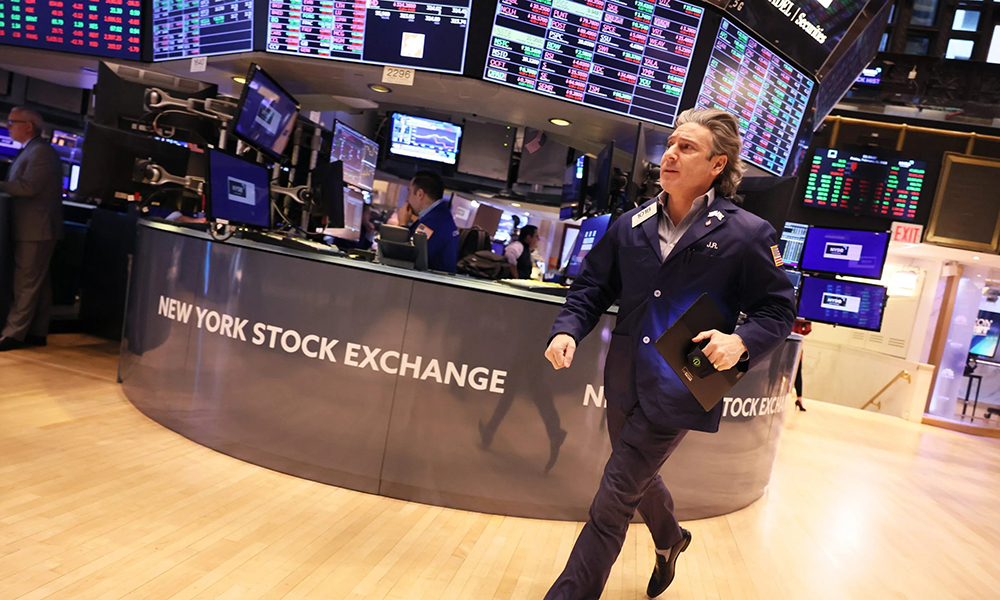
为了保护自己,投资者正准备付出一定的费用,以防本周将公布的关键通胀数据导致股市下跌,预期物价不会像美联储希望看到的那样温和。
市场预计,周二公布的消费者物价指数报告将显示,1月份消费者物价指数年涨幅放缓至6.2%。核心消费者物价指数剔除了波动较大的食品和能源成分,被视为比整体物价消费度量标准更好的基本指标,预计将环比上升0.4%,较上年同期上升5.5%。
但上个月汽油和二手车价格的惊人上涨可能会中断持续数月的通胀放缓趋势,这一趋势促使标准普尔500指数从10月份的低点反弹了14%。
“通货膨胀很可能已经见顶,现在物价正在下降,但这并不意味着物价是线性下降的。”Laffer Tengler Investments的首席投资官南希·滕格勒(Nancy Tengler)说。
毫不令人意外的是,去年消费者物价指数数据发布时,交易市场非常动荡,标准普尔500指数在12个发布日中有7天在下跌。根据彭博社汇编的数据,在过去六个月里,标准普尔500指数在消费者物价指数公布当天的平均上下波动约2.6%,接近2009年以来的最高水平。
交易员们仍然记得去年9月13日公布的消费者物价报告,该报告导致标准普尔500指数暴跌4.3%,创下自2020年3月以来消费者物价报告公布后最糟糕的交易日记录。
Susquehanna International Group衍生品策略联席主管克里斯•墨菲(Chris Murphy)表示:“只要美联储采取鹰派立场,波动性就将保持坚挺。因此,如果消费者物价指数高于预期,市场可能会出现抛售。”
但是,根据彭博行业研究(Bloomberg Intelligence)的数据,股市对过去两个月好于预期的消费者物价指数数据的反应相对平淡,这表明美国股市可能已经将通胀放缓带来的影响计入股价。因此,如果通胀进一步放缓,2023年的消费者物价指数整体波动的天数可能会减少。
现实情况是——至少就目前而言——投资者不必担心,因为任何价格上涨预计都是暂时的。问题是,投资者以前也听说过这种说法。如果强劲的劳动力市场使工资增长保持在高位,并阻止通胀像政策制定者希望的那样快速下降,美联储可能会持续大举加息——或将利率维持在高位的时间比市场预期的更长。
“市场可能对消费者物价指数走高做出负面反应,但这将为长期投资者提供买入股票的机会。”滕格勒说,并指出本季度任何回调都是买入的机会。她在2022年第三季度和第四季度抛售期间增加了公司的股票敞口,并在未来三到五年内看好苹果公司等科技股,并坚持买入网络安全和云服务股票。
但华尔街仍有很大一部分人持怀疑态度。
墨菲说:“我们看到投资者最近进行了更多对冲操作,这很值得关注。”
彭博社汇编的数据显示,对冲未来30天内跟踪标普500指数的最大交易所交易基金下跌10%的风险的合约,目前比从10%的反弹中获利的期权价格高出1.7倍。被称为认沽对认购偏差的价格关系目前徘徊在2022年8月以来的最高水平,当时这个由503个成份股组成的指数持续两个月的上涨突然逆转。
科技股重镇纳斯达克100指数今年因对美联储采取过于激进的措施的担忧有所缓解而攀升了12%,在上周央行行长们警告将在更长时间内采取限制性政策后,该指数正走出2023年以来的首次周线下跌。
尽管迄今为止,第四季度财报季的表现好于人们担忧的情况,但一些基金经理担心,随着美国经济继续放缓或陷入衰退,企业利润最糟糕的时刻尚未到来。在标准普尔500指数从谷底反弹后,这让人们担心科技股和所谓的成长股的估值是否过高。
“我们需要看到通胀数据进一步放缓。”Homrich Berg的首席投资官斯蒂芬妮·朗(Stephanie Lang)说。她所在的公司建议采取防御性投资策略,看好必需消费品和医疗保健类股票。“现在宣布抗击通胀取得胜利、软着陆或降息已成定局还为时过早。”(财富中文网)
本文的撰写得到了马特·特纳(Matt Turner)的协助。
译者:中慧言-王芳
为了保护自己,投资者正准备付出一定的费用,以防本周将公布的关键通胀数据导致股市下跌,预期物价不会像美联储希望看到的那样温和。
市场预计,周二公布的消费者物价指数报告将显示,1月份消费者物价指数年涨幅放缓至6.2%。核心消费者物价指数剔除了波动较大的食品和能源成分,被视为比整体物价消费度量标准更好的基本指标,预计将环比上升0.4%,较上年同期上升5.5%。
但上个月汽油和二手车价格的惊人上涨可能会中断持续数月的通胀放缓趋势,这一趋势促使标准普尔500指数从10月份的低点反弹了14%。
“通货膨胀很可能已经见顶,现在物价正在下降,但这并不意味着物价是线性下降的。”Laffer Tengler Investments的首席投资官南希·滕格勒(Nancy Tengler)说。
毫不令人意外的是,去年消费者物价指数数据发布时,交易市场非常动荡,标准普尔500指数在12个发布日中有7天在下跌。根据彭博社汇编的数据,在过去六个月里,标准普尔500指数在消费者物价指数公布当天的平均上下波动约2.6%,接近2009年以来的最高水平。
交易员们仍然记得去年9月13日公布的消费者物价报告,该报告导致标准普尔500指数暴跌4.3%,创下自2020年3月以来消费者物价报告公布后最糟糕的交易日记录。
Susquehanna International Group衍生品策略联席主管克里斯•墨菲(Chris Murphy)表示:“只要美联储采取鹰派立场,波动性就将保持坚挺。因此,如果消费者物价指数高于预期,市场可能会出现抛售。”
但是,根据彭博行业研究(Bloomberg Intelligence)的数据,股市对过去两个月好于预期的消费者物价指数数据的反应相对平淡,这表明美国股市可能已经将通胀放缓带来的影响计入股价。因此,如果通胀进一步放缓,2023年的消费者物价指数整体波动的天数可能会减少。
现实情况是——至少就目前而言——投资者不必担心,因为任何价格上涨预计都是暂时的。问题是,投资者以前也听说过这种说法。如果强劲的劳动力市场使工资增长保持在高位,并阻止通胀像政策制定者希望的那样快速下降,美联储可能会持续大举加息——或将利率维持在高位的时间比市场预期的更长。
“市场可能对消费者物价指数走高做出负面反应,但这将为长期投资者提供买入股票的机会。”滕格勒说,并指出本季度任何回调都是买入的机会。她在2022年第三季度和第四季度抛售期间增加了公司的股票敞口,并在未来三到五年内看好苹果公司等科技股,并坚持买入网络安全和云服务股票。
但华尔街仍有很大一部分人持怀疑态度。
墨菲说:“我们看到投资者最近进行了更多对冲操作,这很值得关注。”
彭博社汇编的数据显示,对冲未来30天内跟踪标普500指数的最大交易所交易基金下跌10%的风险的合约,目前比从10%的反弹中获利的期权价格高出1.7倍。被称为认沽对认购偏差的价格关系目前徘徊在2022年8月以来的最高水平,当时这个由503个成份股组成的指数持续两个月的上涨突然逆转。
科技股重镇纳斯达克100指数今年因对美联储采取过于激进的措施的担忧有所缓解而攀升了12%,在上周央行行长们警告将在更长时间内采取限制性政策后,该指数正走出2023年以来的首次周线下跌。
尽管迄今为止,第四季度财报季的表现好于人们担忧的情况,但一些基金经理担心,随着美国经济继续放缓或陷入衰退,企业利润最糟糕的时刻尚未到来。在标准普尔500指数从谷底反弹后,这让人们担心科技股和所谓的成长股的估值是否过高。
“我们需要看到通胀数据进一步放缓。”Homrich Berg的首席投资官斯蒂芬妮·朗(Stephanie Lang)说。她所在的公司建议采取防御性投资策略,看好必需消费品和医疗保健类股票。“现在宣布抗击通胀取得胜利、软着陆或降息已成定局还为时过早。”(财富中文网)
本文的撰写得到了马特·特纳(Matt Turner)的协助。
译者:中慧言-王芳
Investors are paying up to protect themselves in case the stock market sinks with a key inflation reading due this week, which is expected to show that prices aren’t moderating the way the Federal Reserve would like to see.
Tuesday’s consumer price index report is forecast to show a deceleration in annual price growth to 6.2% in January. The core CPI, which strips out volatile food and energy components and is seen as a better underlying indicator than the headline measure, is projected to rise 0.4% month over month and 5.5% from a year earlier.
But a surprising rise in gas and used-car prices last month may interrupt the monthslong trend of decelerating inflation that spurred a 14% rebound in the S&P 500 from its low in October.
“Inflation has most likely peaked and now prices are on their way down, but that doesn’t mean it’s a linear way down — and that’s OK,” Nancy Tengler, chief investment officer of Laffer Tengler Investments, said.
Not surprisingly, trading sessions last year were turbulent when CPI data were released, with the S&P 500 falling on seven of the 12 reporting days. Over the past six months, the S&P 500 has seen an average move of about 2.6% in either direction on the day CPI has been released — near the highest since 2009 — according to data compiled by Bloomberg.
Traders still remember the consumer price report on Sept. 13, which sent the S&P 500 plummeting 4.3% for its worst CPI session since March 2020.
“As long as the Fed is in a hawkish mode, volatility will remain firm,” said Chris Murphy, co-head of derivatives strategy at Susquehanna International Group. “So if CPI comes in higher than expected, the market will likely sell off.”
But the stock market’s relatively muted reaction to the past two months of better-than-expected CPI prints signal that US equities may have already priced in slowing inflation, according to Bloomberg Intelligence. As a result, there may be fewer turbulent CPI days overall in 2023 if the data eases further.
The reality — at least for now — is that investors shouldn’t worry because any uptick in prices is expected to be temporary. The problem is investors have heard that before. If a strong labor market keeps wage growth elevated and prevents inflation from coming down as fast as policymakers want, the Fed may raise rates more aggressively — or hold them higher for longer — than the markets had been expecting.
“The market may react negatively to a hotter CPI, but that will provide an opportunity for longer-term investors to buy equities,” said Tengler, noting that any pullback this quarter is an opportunity to buy. She added to the firm’s equity exposure during selloffs in the third and fourth quarters of 2022, and favors technology stocks like Apple Inc. over the next three to five years and is sticking with cyber security and cloud services.
But skepticism remains among a large contingent on Wall Street.
“We’ve definitely seen more notable hedging recently among investors,” Murphy said.
Contracts protecting against a 10% decline in the largest exchange-traded fund tracking the S&P 500 in the next 30 days currently cost 1.7 times more than options that profit from a 10% rally, data compiled by Bloomberg show. The price relationship, known as put-to-call skew, is hovering at the highest level since August 2022, when a two-month rally in the 503-member index abruptly reversed.
The tech-heavy Nasdaq 100 Index, which has climbed 12% this year on dialed back fears of an overly aggressive Fed, is coming off its first weekly loss in 2023 after a chorus of central bankers warned of restrictive policy for longer last week.
Although fourth-quarter earnings season has been better than feared thus far, some money managers worry that the worst is yet to come for company profits as the US economy continues to slow or lapses into a recession. This has raised concerns about whether valuations for tech and so-called growth shares are too high after the S&P 500’s rebound from its trough.
“We need to see the inflation data improve even further,” said Stephanie Lang, chief investment officer at Homrich Berg, whose firm recommends being defensively positioned in favor of consumer staples and health-care companies. “It’s premature to declare victory on the inflation battle and that a soft landing or rate cuts are a foregone conclusion.”
With assistance from Matt Turner






